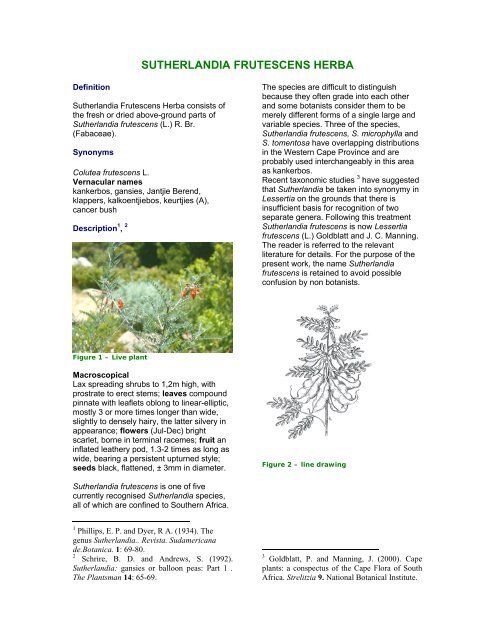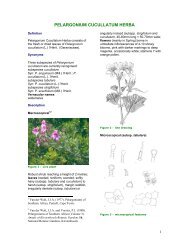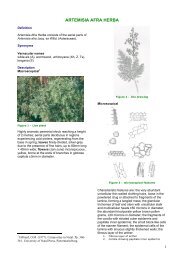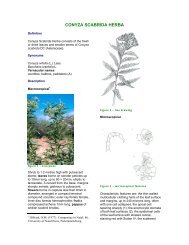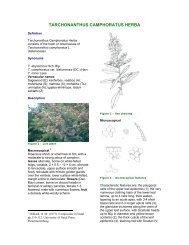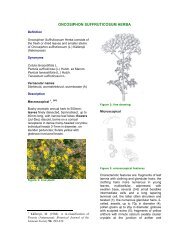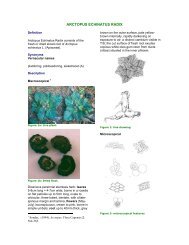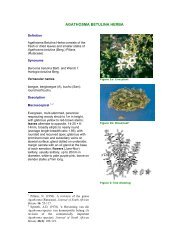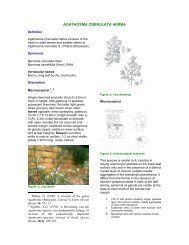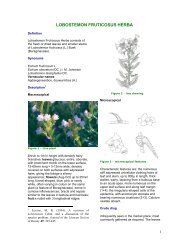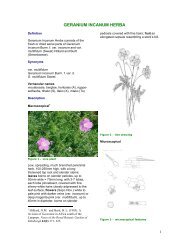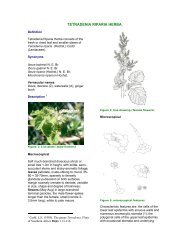SUTHERLANDIA HERBA - PlantZAfrica
SUTHERLANDIA HERBA - PlantZAfrica
SUTHERLANDIA HERBA - PlantZAfrica
Create successful ePaper yourself
Turn your PDF publications into a flip-book with our unique Google optimized e-Paper software.
Definition<br />
<strong>SUTHERLANDIA</strong> FRUTESCENS <strong>HERBA</strong><br />
Sutherlandia Frutescens Herba consists of<br />
the fresh or dried above-ground parts of<br />
Sutherlandia frutescens (L.) R. Br.<br />
(Fabaceae).<br />
Synonyms<br />
Colutea frutescens L.<br />
Vernacular names<br />
kankerbos, gansies, Jantjie Berend,<br />
klappers, kalkoentjiebos, keurtjies (A),<br />
cancer bush<br />
Description 1 , 2<br />
Figure 1 – Live plant<br />
Macroscopical<br />
Lax spreading shrubs to 1,2m high, with<br />
prostrate to erect stems; leaves compound<br />
pinnate with leaflets oblong to linear-elliptic,<br />
mostly 3 or more times longer than wide,<br />
slightly to densely hairy, the latter silvery in<br />
appearance; flowers (Jul-Dec) bright<br />
scarlet, borne in terminal racemes; fruit an<br />
inflated leathery pod, 1.3-2 times as long as<br />
wide, bearing a persistent upturned style;<br />
seeds black, flattened, ± 3mm in diameter.<br />
Sutherlandia frutescens is one of five<br />
currently recognised Sutherlandia species,<br />
all of which are confined to Southern Africa.<br />
1 Phillips, E. P. and Dyer, R A. (1934). The<br />
genus Sutherlandia.. Revista. Sudamericana<br />
de.Botanica. 1: 69-80.<br />
2 Schrire, B. D. and Andrews, S. (1992).<br />
Sutherlandia: gansies or balloon peas: Part 1 .<br />
The Plantsman 14: 65-69.<br />
The species are difficult to distinguish<br />
because they often grade into each other<br />
and some botanists consider them to be<br />
merely different forms of a single large and<br />
variable species. Three of the species,<br />
Sutherlandia frutescens, S. microphylla and<br />
S. tomentosa have overlapping distributions<br />
in the Western Cape Province and are<br />
probably used interchangeably in this area<br />
as kankerbos.<br />
Recent taxonomic studies 3 have suggested<br />
that Sutherlandia be taken into synonymy in<br />
Lessertia on the grounds that there is<br />
insufficient basis for recognition of two<br />
separate genera. Following this treatment<br />
Sutherlandia frutescens is now Lessertia<br />
frutescens (L.) Goldblatt and J. C. Manning.<br />
The reader is referred to the relevant<br />
literature for details. For the purpose of the<br />
present work, the name Sutherlandia<br />
frutescens is retained to avoid possible<br />
confusion by non botanists.<br />
Figure 2 – line drawing<br />
3 Goldblatt, P. and Manning, J. (2000). Cape<br />
plants: a conspectus of the Cape Flora of South<br />
Africa. Strelitzia 9. National Botanical Institute.
Microscopical<br />
Figure 3 – microscopical features<br />
Characteristic features are<br />
The very numerous unicellular stiff clothing<br />
hairs, up to 200 microns in length, with warty<br />
walls, adpressed to the leaf surface and<br />
along leaf margins (3); the straight-walled,<br />
polygonal cells of both upper and lower leaf<br />
surfaces (1), papillate in sectional view; the<br />
small stomata (± 20 microns in length); the<br />
bifacial structure of the leaf lamina (2); the<br />
absence of calcium oxalate crystals<br />
Crude drug<br />
Supplied in bundles of fresh or dried<br />
material, consisting of leaf and stem only or<br />
including flowers and fruit. The foliage is<br />
grey-green in colour, the fruits green flushed<br />
with red; the herb has a characteristic bitter<br />
and slightly aromatic odour.<br />
Geographical distribution<br />
Figure 4 – distribution map<br />
Widespread in drier areas of the South<br />
Western and Northern Cape Provinces;<br />
often as a weed of disturbed places e.g.<br />
road verges.<br />
Quality standards<br />
Identity tests<br />
Figure 5 – TLC plate<br />
Thin layer chromatography on silica gel<br />
using as solvent a mixture of toluene:diethyl<br />
ether:1.75M acetic acid (1:1:1). Reference<br />
compound cineole (0,1% in chloroform).<br />
Method according to Appendix 2a.<br />
Rf values of major compounds: 0, 50<br />
(yellow-green); 0, 63 (purple); 0, 91 (purple);<br />
cineole: 0, 81 (blue-purple)<br />
HPLC on C18 column, method according to<br />
Appendix 2b.<br />
Major compounds:<br />
Figure 6 – HPLC spectrum
Methanol extract: (Figure 6)<br />
Retention times (mins): 19.88; 20.68<br />
Ethanol (70%) soluble extractive value:<br />
not less than 27% (range: 27.22-38.90%)<br />
Purity tests<br />
Assay<br />
Not yet available<br />
Major chemical constituents<br />
Figure 7 – chemical constituents<br />
Microchemical tests in our laboratories<br />
indicated the presence of tannins but no<br />
alkaloids, cardiac glycosides, saponins or<br />
anthraquinone derivatives. The non-protein<br />
α-amino acid canavanine has been detected<br />
in the seeds of this species but not in other<br />
organs 4 . Free amino acids are reported as<br />
common constituents of Sutherlandia<br />
frutescens. 5<br />
Dosage forms<br />
Used mainly as an aqueous infusion or<br />
decoction, either internally or externally as<br />
an antiseptic wash, eye lotion or douche.<br />
Whole fruits may be chewed for the relief of<br />
stomach pains.<br />
4 Bell, E.A. et al. (1978). The systematic<br />
significance of canavanine in the Papilionoideae.<br />
Biochemical Systematics and Ecology 6: 201-<br />
212.<br />
5 Van Wyk, B-E., Gericke, N.P.and van<br />
Oudtshoorn, B. (1997). Medicinal plants of<br />
South Africa. Briza Publications, Pretoria.<br />
Medicinal uses<br />
Internal<br />
For the treatment of cancer, gastric<br />
ailments, gynaecological problems,<br />
backache, rheumatism, oedema and fevers;<br />
also as a bitter tonic or blood purifier.<br />
External<br />
For the treatment of eye infections and<br />
wounds; as a douche for prolapse of the<br />
uterus.<br />
Pharmacology/bioactivity<br />
Studies using 50% ethanol extracts of fresh<br />
flowers of Sutherlandia frutescens found no<br />
antitumour activity against CA-Lewis lung,<br />
Leuk-L1210 or Sarcoma 180 (solid) tumours<br />
in the mouse. Similar extracts, assayed for<br />
cytotoxicity against CA-9KB cell lines, at a<br />
concentration of 20.0 mcg/ml, proved<br />
inactive. 6<br />
No in vitro antimicrobial activity against<br />
Pseudomonas aeruginosa, Candida<br />
albicans or Mycobacterium smegmatis was<br />
observed in the concentrations used for disc<br />
assays in our laboratories. Some activity<br />
was recorded against Staphylococcus<br />
aureus.<br />
Research into anticancer and<br />
immunomodulatory activity of this species is<br />
currently in progress. The results appear<br />
promising.<br />
Contraindications<br />
The use of this herb is not recommended<br />
during pregnancy.<br />
Adverse reactions<br />
The use of excessive amounts of this herb<br />
are reputed to cause emesis. Side effects of<br />
moderate use include sweating and mild<br />
purgation.<br />
Precautions<br />
6 Charlson, A.J. (1980). Antineoplastic<br />
constituents of some Southern African plants.<br />
Journal of Ethnopharmacology 2(4): 323-335.
Investigations in our laboratories of different<br />
collections of this herb suggests that it is<br />
biochemically variable and that distinct<br />
chemical races of the species may exist in<br />
different parts of its distribution range. These<br />
may vary in potency and bioactivity.<br />
Dosage<br />
Half a bunch (±10g = 3 tablespoonsful) of<br />
dried ground herb is infused until cold with<br />
one litre of boiling water, then strained and<br />
taken in half teacupful doses (90ml) three<br />
times daily. Children 6 –12 years: one<br />
quarter teacupful (45ml).<br />
Copyright in this monograph resides with the authors, the South<br />
African National Biodiversity Institute, the South African Medical<br />
Research Council and the University of the Western Cape. It may<br />
not be reproduced in whole or in part without the written consent of<br />
the copyright holders.


